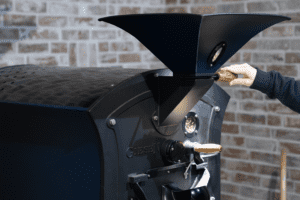Welcome to ‘The Holy Grail of consistency’. In this episode, Willem discusses the subject ‘consistency’. We are so excited to share our enthusiasm about the great profession and craft of roasting coffee. We hope you love it as much as we do. Last month Willem talked about ‘pressure profiling’. Missed that one? Click here. Enjoy the sixth episode of ‘Behind the Roast’ with Willem Boot!
Consistency and customers
I consider the consistency of roasted coffee quality as one of the holy grails for the long-term success of a coffee brand or company. As a matter of fact, most customers prefer not to complain when they feel disappointed about the coffee experience in their favorite café or when they taste that something is off with the flavor of the roasted beans. Consumer research has proven that, instead of complaining, consumers usually keep quiet and silently seek other brands which can offer them the product satisfaction they seek.
Times have changed
During my early years working as a rookie coffee entrepreneur, I learned this the hard way. Years ago, quality inspection protocols simply weren’t as sophisticated as they are now and basic measuring tools, like color meters, and humidity analyzers were too expensive. Fortunately, the times have been changing and nowadays there shouldn’t be any excuse to be complacent about the management of your roasted coffee quality. Maintaining consistent flavor profiles requires careful analysis of the entire quality cycle of your coffee; from green bean purchasing to roasted coffee handling to brewing protocols. The final resulting flavors in the cup depend on every single step in this complex journey.
Example
Quite recently, one of our international roaster clients asked me to investigate the consistent complaints of one of their long-time customers operating a small chain of cafés in Southern Asia. I interviewed the owner and she talked about the seven-year relationship with the roasted coffee supplier and how the flavor had changed; from sweet and balanced to a profile that started displaying a slightly drying and harsh aftertaste. The quality issue had also become controversial with some of her own clients. During my last visit to Asia, I tasted the coffee in one of her cafés and my hunch was that possibly the roasting process of this blend might have been too hot and too fast. My assessment was quite “on the money” and ultimately the roaster adjusted the burner settings of their machine which fixed the problem. We learned a valuable lesson from this experience! Make sure that you read the checklist describing possible causes of roasting inconsistencies and good luck with your roasting journey.
Guidelines for Coffee Roasting Consistency
These guidelines are a helpful diagnostic tool if you’re encountering problems or challenges with the consistency of the quality of your roasted coffee. The most common causes of coffee roasting inconsistencies are listed in this overview. Below you can download the brief overview of these guidelines and underneath this download, you can see the full description of each guideline.
EXTERNAL PARAMETERS
The calibration of your roasting machine and the performance of your roaster can gradually change and fluctuate. Below are the more common interventions to adjust the performance of your machine.
- Mechanical roaster maintenance. These adjustments often require the assistance of a qualified technician. Common maintenance requirements that can occur include: greasing essential bearings, adjusting the drum alignment, inspecting the performance of motors and fans, and adjusting the alignment of fans and motors.
- Cleaning practices inside the machine and of exhaust ducting. The lack of frequent cleaning practices is often a root cause of roaster fires and of gradual changes in the flavor profile of your coffee. Develop a daily, weekly, and monthly cleaning schedule to prevent chaff build-up and to guarantee that the airflow inside the roaster and inside the exhaust ducting remains constant.
- Calibration of gas pressure and burners. Ideally, the flames of your roaster are blue, which indicates that the combustion of the gases evolves efficiently. Yellow flames are a sign that the burners are dirty or that the gas pressure must be adjusted. Consult a gas technician to make adjustments.
- Gas quality. Some countries use gas types that can require a gas technician to replace gas burner orifices or to calibrate the settings of your burners.
COFFEE QUALITY FACTORS
Coffee is a natural product and for that reason, changes in bean quality are often inevitable. The roasting professional must be able to recognize these deviations in order to minimize the impact on the quality of the roasted coffee.
- Changing green coffee quality characteristics. The quality features of green coffee beans are dependent on many factors: weather patterns, processing protocols, and other outside influences like pests and diseases. Stringent grading and cupping protocols can help you to flag unexpected and unwanted changes.
- Drying practices at origin: moisture, water activity. The moisture content of green coffee beans should be between 10 and 12%. Most of this moisture is contained in the cellular structure as free water. Measuring the moisture content can be accomplished with a moisture analyzer. Water activity is basically the measure of the energy status of the water left in the coffee. It tells us whether or not the moisture is stable at the cellular level. It should not exceed 0.7 and not be less than 0.4. If the water activity is too high, then the green coffee will deteriorate too fast during the storage of the coffee beans.
- Green bean storage, temperature conditions, relative humidity, packaging of green coffee. The shelve life of green coffee greatly depends on these factors. The space where your green coffee is stored must offer optimal conditions to preserve the flavor profile of your precious coffee. The temperature must ideally be maintained at a constant level below 20 degrees Celsius at a consistent relative humidity between 30 to 70 percent. Make sure that the coffee doesn’t touch the floor or walls directly by using storage racks and pallets.
- Roasting Practices for color consistency by knowing what color you want and by controlling the preferred RoR (rate of rise) during the roasting cycle. Your quality procedures during and after the roasting of the coffees can reduce possible inconsistencies of roast colors and of flavor profiles. Roasting software applications, like the Giesen Roast Profiler, and color samples of roasted coffee near your machine will help you to determine the ideal levels of roast color development. The efficiency and speed of your cooling system can prevent unnecessary baking of the roasted beans during the cooling cycle.
POST ROASTING FACTORS
Once the roasting is completed, it becomes essential to maintain the best possible freshness of your roasted coffee. Roasted coffee requires cool and dry storage conditions with the absence of direct light and ideally in a low oxygen environment. The more you can control these factors, the longer you’ll be able to maintain the flavor profile of your specialty coffee. The acceptable shelve life of roasted beans can vary from three weeks to three months. Of course, this also depends on how strictly you set your quality expectations. Highly specialized roasters prefer to rotate their roasted beans at least every three weeks. Roasters with regional, national or international distribution cycles often use sophisticated packaging structures and protocols with acceptable freshness timelines that can exceed 6 months or even more.
Willem Boot
Willem Boot is Brand Ambassador of Giesen Coffee Roasters and founder of Boot Coffee Campus, a leading coffee training institute for the coffee industry. Check the program of specialized courses at www.bootcoffee.com.







Dit bericht heeft één reactie
The more I delve into your world, the more I am amazed at your services to the customer. “Really, thank you for being here.”